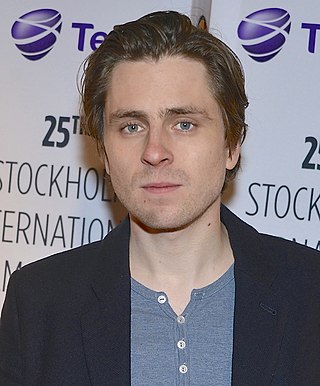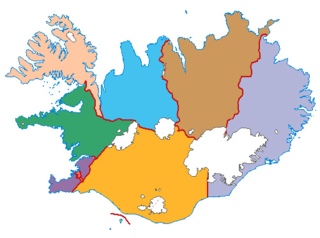
Vatnajökull is the largest and most voluminous ice cap in Iceland, and the second largest in area in Europe after the Severny Island ice cap of Novaya Zemlya. It is in the south-east of the island, covering approximately 10% of the country.
COBRA or Cobra, often stylized as CoBrA, was a European avant-garde art group active from 1948 to 1951. The name was coined in 1948 by Christian Dotremont from the initials of the members' home countries' capital cities: Copenhagen (Co), Brussels (Br), Amsterdam (A).

Goðafoss is a waterfall in northern Iceland. It is located along the country's main ring road at the junction with the Sprengisandur highland road, about 45 minutes from Akureyri. The water of the river Skjálfandafljót falls from a height of 12 metres over a width of 30 metres. A 1.8-mile hiking trail loops around the waterfall area.

Gljúfrasteinn is a writer's home museum, which was the former home of Halldór Kiljan Laxness, a 1955 Nobel Prize for Literature winner. It is located in Mosfellsbær, east of Reykjavík, Iceland. The name of the house is derived from a large stone in the vicinity called Gljúfrasteinn, about which Halldór wrote the short story "Steinninn minn helgi" at the age of 19.

Svavar Pétur Eysteinsson, better known by his stage name Prins Póló, was an Icelandic singer-songwriter and experimental artist. He was also part of the Icelandic band Skakkamanage.
Icelandic art has been built on northern European traditions of the nineteenth century, but developed in distinct directions in the twentieth century, influenced in particular by the unique Icelandic landscape as well as by Icelandic mythology and culture.

Sverrir Páll Guðnason is a Swedish and Icelandic actor.
Karl Kvaran was an Icelandic painter and draughtsman. He is considered one of the principal exponents of the geometric abstractionist school of painting in Iceland in the early sixties.
Torkil Gudnason is a New York based fashion photographer.
Svavar Gestsson was an Icelandic politician and Minister for Social Affairs, Minister for Culture and Education in the cabinet of Steingrímur Hermannsson (1988–1991), Member of Parliament (1978–1999), and Ambassador (1999–2009).

Svavar Knútur is the stage name of Icelandic singer-songwriter Svavar Knútur Kristinsson, from the Northwest of Iceland and the Eastfjords, but living in the town of Akureyri. He sings in Icelandic and English, Svavar Knútur collaborated with Czech singer-songwriter Markéta Irglová on his album Ölduslóð . Svavar Knútur has in recent years toured extensively around Europe as well as doing some touring of Australia and North America. Svavar Knútur is one of the founding members and curators of the Melodica festival, curating the Reykjavík branch of the festival. In the German town of Schleswig Svavar Knútur has played multiple times on the Norden Festival in 2018, 2019 and 2023.
The following lists events that happened in 1939 in Iceland.
The following lists events that happened in 1909 in Iceland.
Events in the year 2017 in Iceland.
Iceland was represented at the Eurovision Song Contest 1988 by Beathoven with the song "Þú og þeir (Sókrates)". Beathoven was the winner of the Icelandic national final, Söngvakeppni Sjónvarpsins 1988, organised by Icelandic broadcaster Ríkisútvarpið (RÚV).
Þórólfur Guðnason is an Icelandic doctor who serverd as the Chief Epidemiologist of the Icelandic Directorate of Health from 2015 to 2022. He was one of the lead members of the Iceland's Department of Civil Protection and Emergency Management addressing the COVID-19 pandemic in Iceland, along with Alma Möller and Víðir Reynisson.
Events in the year 2021 in Iceland.

Reykjavík was one of the multi-member constituencies of the Althing, the national legislature of Iceland. The constituency was established in 1844 when the Althing was converted into a consultative assembly. It was abolished in 2003 when the constituency was split into two constituencies following the re-organisation of constituencies across Iceland. Reykjavík was conterminous with the municipality of Reykjavík.






